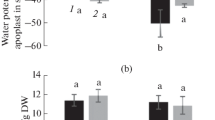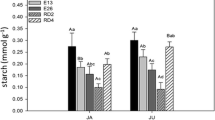Summary
Aspects of osmoregulation were studied in leaves of irrigated and nonirrigated plants of Atriplex hymenelytra (Torr.) Wats. (Chenopodiaceae) from their natural habitat in Death Valley, California. Using a set of several data concentrations of inorganic electrolytes (Na+, K+, Cl-) and of oxalate in the mesophyll of this salt secreting species were calculated. The osmotic potential resulting from these solutes (under consideration of an empirically estimated osmotic coefficient) is in good agreement with field measurements of the overall osmotic potential in the leaf mesophyll as determined by pressure-volume curves. This indicates that these 4 electrolytes are the main osmotically active solutes. Oxalate is present in comparably high concentrations and is used to achieve ion balance.
Organic solutes analyzed include soluble carbohydrates (mono-, di- and oligosaccharides), amino- and organic acids as well as glycinebetaine. Of these, organic- and amino acids (including proline) contribute only little to osmoregulation. Soluble carbohydrates and especially glycinebetaine exhibit concentrations high enough for generating considerable osmotic potentials, at least if these compounds are regarded to be restricted to the cytoplasm acting as compatible solutes.
Similar content being viewed by others
References
Albert R (1982) Halophyten. In: Kinzel H (ed) Pflanzenökologie und Mineralstoffwechsel Ulmer, Stuttgart, pp 33–204
Albert R, Popp M (1978) Zur Rolle der löslichen Kohlenhydrate in Halophyten des Neusiedlersee-Gebietes (Österreich). Oecol Plant 13:27–42
Batanouny KH, Ebeid MM (1981) Diurnal changes in proline content of desert plants. Oecologia (Berlin) 51:250–252
Bennert HW (1981) Untersuchungen zum Kohlenstoffhaushalt von Atriplex hymenelytra (Torr.) Wats. (Chenopodiaceae) unter Wasserstreß. Verhandl Ges Ökol 9:129–134
Bennert HW, Mooney HA (1979) The water relations of some desert plants in Death Valley, California. Flora 168:405–427
Bennert HW, Schmidt B (1983) Untersuchungen zur Salzabscheidung bei Atriplex hymenelytra (Torr.) Wats (Chenopodiaceae). Flora 174:341–355
Boehringer Mannheim GmbH (1983) Methoden der enzymatischen Lebensmittelanalytik mit Einzelreagentien. Mannheim
Caldwell MM (1974) Physiology of desert halophytes. In: Reimold RJ, Queen WH (eds) Ecology of halophytes. Academic Press, New York London, pp 355–378
Cavalieri AJ, Huang AHC (1979) Evaluation of proline accumulation in the adaptation of diverse species of marsh halophytes to the saline environment. Amer J Bot 66:307–312
Cavalieri AJ, Huang AHC (1981) Accumulation of proline and glycinebetaine in Spartina alterniflora Loisel. in response to NaCl and nitrogen in the marsh. Oecologia (Berlin) 49:224–228
Flowers TJ, Hall JL (1978) Salt tolerance in the halophyte, Suaeda maritima (L.) Dum.: The influence of the salinity of the culture solution on the content of various organic compounds. Ann Bot 42:1057–1063
Flowers TJ, Troke PF, Yeo AR (1977) The mechanism of salt tolerance in halophytes. Ann Rev Plant Physiol 28:89–121
Gorham J, Hughes LL, Wyn Jones RG (1980) Chemical composition of salt-marsh plants from Ynys Môn (Anglesey): the concept of physiotypes. Plant Cell Environment 3:309–318
Greenway H, Munns R (1980) Mechanism of salt tolerance in nonhalophytes. Ann Rev Plant Physiol 31:149–190
Harvey DMR, Hall JL, Flowers TJ, Kent B (1981) Quantitative ion localization within Suaeda maritima leaf mesophyll cells. Planta 151:555–560
Hellebust JA (1976) Osmoregulation. Ann Rev Plant Physiol 27:485–505
Hitz WD, Hanson AD (1980) Determination of glycine betaine by pyrolysis-gas chromatography in cereals and grasses. Phytochem 19:2371–2374
Holländer H (1979) Inhibitoren der Phenylpropansynthese in Fagopyrum esculentum Moench. Diss Bochum
Huber W, Eder A (1982) Prolin- und Glycinbetain-Anhäufung in Blättern und Sproßachsen von Euphorbia trigona und deren Bedeutung bei mangelnder Wasserversorgung. Biochem Physiol Pflanz 177:184–191
Jefferies RL, Rudmik T, Dillon EM (1979) Responses of halophytes to high salinities and low water potentials. Plant Physiol 64:989–994
Kaplan A, Gale J (1974) Modification of the pressure-bomb technique for measurement of osmotic potential in halophytes. J Exper Bot 25:663–668
Lambers H, Blacquière T, Stuiver B (1981) Interactions between osmoregulation and the alternative respiratory pathway in Plantago coronopus as effected by salinity. Physiol Plant 51:63–68
Larher F, Jolivet Y, Briens M, Goas M (1982) Osmoregulation in higher plant halophytes: Organic nitrogen accumulation in glycine betaine and proline during the growth of Aster tripolium and Suaeda macrocarpa under saline conditions. Plant Sci Letters 24:201–210
Neales TF, Sharkey PJ (1981) Effect of salinity on growth and on mineral and organic constituents of the halophyte Disphyma australe (Solan.) J.M. Black. Aust J Plant Physiol 8:165–179
Osmond CB (1963) Oxalates and ionic equilibria in Australian saltbushes (Atriplex). Nature 198:503–504
Osmond CB, Björkman O, Anderson DJ (1980) Physiological processes in plant ecology. Toward a synthesis with Atriplex. Ecological studies, vol 36. Springer, Berlin Heidelberg New York
Pourrat Y, Hubac C (1974) Comparaison des mécanismes de la résistance à la sécheresse chez deux plantes désertiques: Artemisia herba alba Asso et Carex pachystylis (J. Gay) Asch. et Graebn. Physiol Vég 12:135–147
Roberts SW, Knoerr KR (1977) Components of water potential estimated from xylem pressure measurements in five tree species. Oecologia (Berlin) 28:191–202
Singh G, Rai VK (1981) Free proline accumulation and drought resistance in Cicer arietinum L. Biol Plant 23:86–90
Skujins J (1981) Nitrogen cycling in arid ecosystems. In: Clark FE, Rosswall T (eds) Terrestrial nitrogen cycles. Ecol Bull 33:474–491
Stelzer R (1981) Ion localization in the leaves of Puccinellia peisonis. Z Pflanzenphysiol 103:27–36
Stewart CR (1978) Role of carbohydrates in proline accumulation in wilted barley leaves. Plant Physiol 61:775–778
Storey R, Wyn Jones RG (1977) Quaternary ammonium compounds in plants in relation to salt resistance. Phytochem 16:447–453
Storey R, Wyn Jones RG (1978) Salt stress and comparative physiology in the Gramineae. III. Effect of salinity upon ion relations and glycinebetaine and proline levels in Spartina x townsendii. Aust J Plant Physiol 5:831–838
Storey R, Wyn Jones RG (1979) Responses of Atriplex spongiosa and Suaeda monoica to salinity. Plant Physiol 63:156–162
Storey R, Ahmad N, Wyn Jones RG (1977) Taxonomic and ecological aspects of the distribution of glycinebetaine and related compounds in plants. Oecologia (Berlin) 27:319–332
Treichel S (1979) Der Einfluß von NaCl auf den Prolinstoffwechsel bei Halophyten. Ber Deutsch Bot Ges 92:73–85
Tymms MJ, Gaff DF (1979) Proline accumulation during water stress in resurrection plants. J Exper Bot 30:165–168
Tyree MT, Jarvis PG (1982) Water in tissues and cells. In: Lange OL, Nobel PS, Osmond CB, Ziegler H (eds) Physiological plant ecology II Water relation and carbon assimilation (=Encyclopedia of plant physiology NS vol 12B). Springer, Berlin Heidelberg New York, pp 35–77
Walter H (1968) Die Vegetation der Erde in öko-physiologischer Betrachtung. Bd II Die gemäßigten und arktischen Zonen. Fischer, Stuttgart
Wyn Jones RG, Storey R (1978) Salt stress and comparative physiology in the Gramineae. II. Glycinebetaine and proline accumulation in two salt- and water-stressed barley cultivars. Aust J Plant Physiol 5:817–829
Yeo AR (1981) Salt tolerance in the halophyte Suaeda maritima L. Dum.: Intracellular compartmentation of ions. J Exper Bot 32:487–497
Author information
Authors and Affiliations
Rights and permissions
About this article
Cite this article
Bennert, H.W., Schmidt, B. On the osmoregulation in Atriplex hymenelytra (Torr.) Wats. (Chenopodiaceae). Oecologia 62, 80–84 (1984). https://doi.org/10.1007/BF00377377
Received:
Issue Date:
DOI: https://doi.org/10.1007/BF00377377




